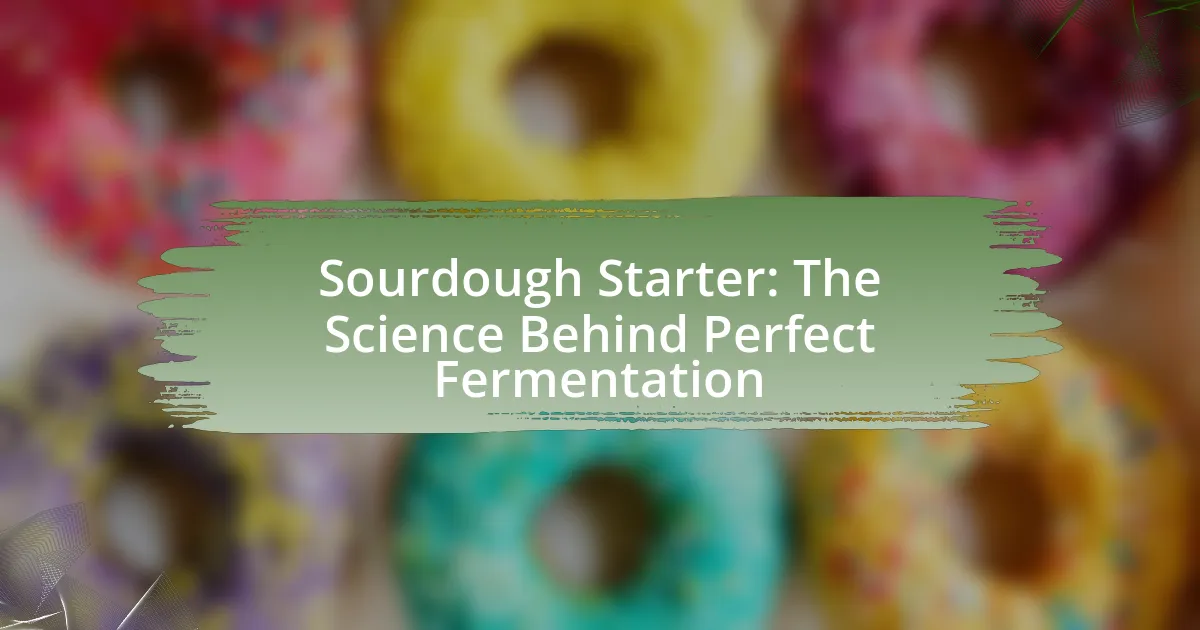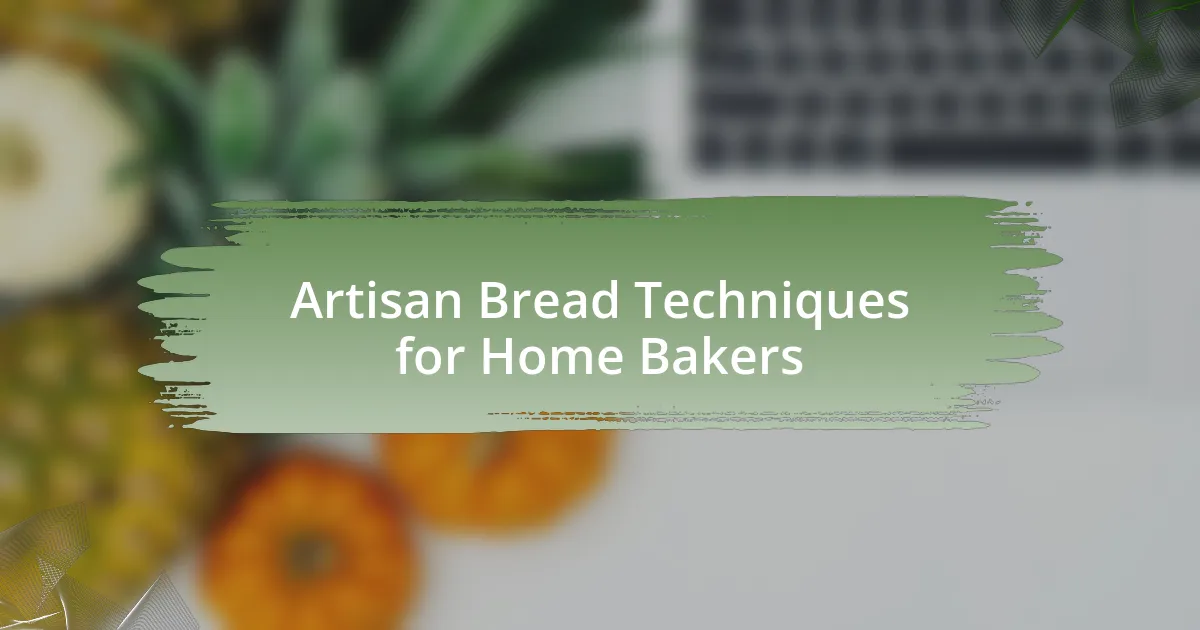Gluten-free bread recipes are designed to create bread without gluten, utilizing alternative flours such as almond, coconut, and rice flour, along with binding agents like xanthan gum. These recipes cater to individuals with celiac disease and gluten sensitivities, as well as those seeking gluten-free options for health reasons. The article explores the differences between gluten-free and traditional bread recipes, common ingredients, various types of gluten-free bread, and techniques for successful baking. Additionally, it provides insights on troubleshooting common issues, storage methods, and creative uses for gluten-free bread, making it a comprehensive resource for anyone interested in gluten-free baking.
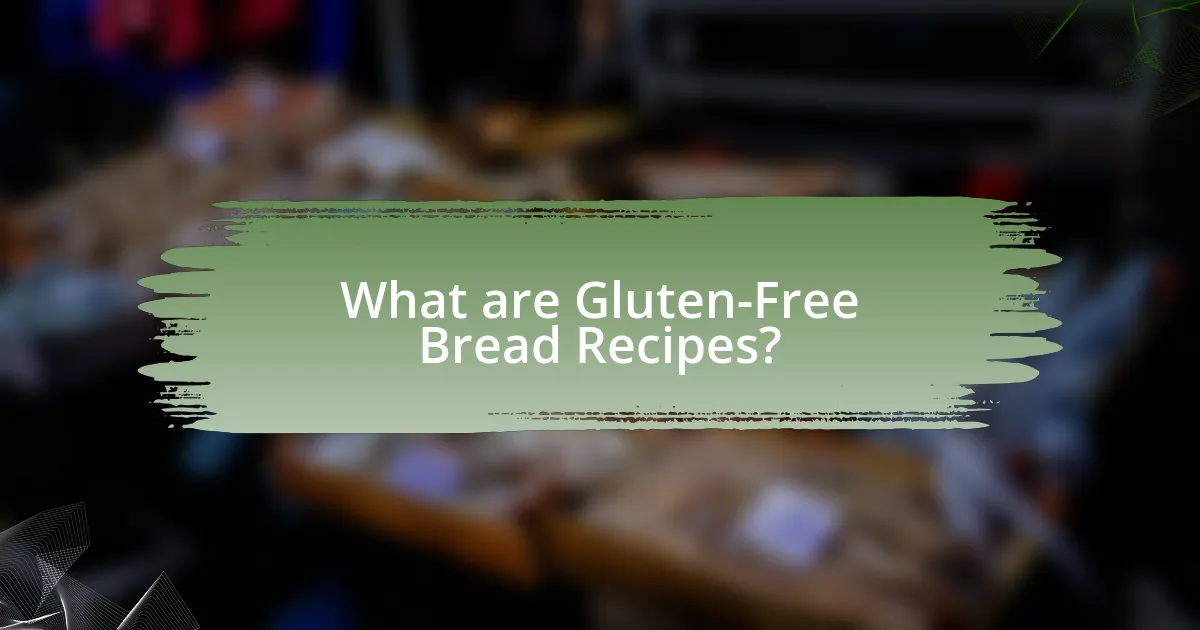
What are Gluten-Free Bread Recipes?
Gluten-free bread recipes are formulations designed to create bread without gluten, a protein found in wheat, barley, and rye. These recipes typically utilize alternative flours such as almond flour, coconut flour, or rice flour, combined with binding agents like xanthan gum or psyllium husk to achieve the desired texture and rise. The demand for gluten-free options has increased, with approximately 1% of the population diagnosed with celiac disease, necessitating gluten-free diets. Additionally, many individuals choose gluten-free diets for perceived health benefits, further driving the popularity of gluten-free bread recipes.
How do gluten-free bread recipes differ from traditional bread recipes?
Gluten-free bread recipes differ from traditional bread recipes primarily in their use of alternative flours and binding agents, as traditional bread relies on gluten-containing wheat flour for structure and elasticity. Gluten-free recipes typically incorporate flours such as almond, coconut, rice, or tapioca, which do not provide the same elasticity, necessitating the addition of binders like xanthan gum or psyllium husk to mimic the texture of gluten. This fundamental difference in ingredients results in variations in taste, texture, and rising methods, as gluten-free breads often require different leavening techniques and longer baking times to achieve a desirable consistency.
What ingredients are commonly used in gluten-free bread recipes?
Common ingredients in gluten-free bread recipes include gluten-free flours such as almond flour, coconut flour, and rice flour. These flours serve as the primary base for the bread, providing structure and texture. Additionally, binding agents like xanthan gum or psyllium husk are often used to mimic the elasticity of gluten, enhancing the bread’s consistency. Other ingredients may include eggs for moisture and leavening agents like baking powder or yeast to promote rising. The combination of these ingredients allows for the creation of gluten-free bread that is both palatable and structurally sound.
Why is gluten-free bread important for certain dietary needs?
Gluten-free bread is important for individuals with celiac disease or gluten sensitivity because it allows them to consume bread without triggering adverse health reactions. Celiac disease affects approximately 1% of the population, causing an autoimmune response when gluten is ingested, which can lead to severe digestive issues and long-term health complications. Gluten-free bread provides a safe alternative, enabling those with these dietary needs to enjoy bread products without compromising their health.
What types of gluten-free bread recipes are available?
Various types of gluten-free bread recipes are available, including almond flour bread, coconut flour bread, and chickpea flour bread. Almond flour bread is popular for its nutty flavor and moist texture, while coconut flour bread is known for its lightness and high fiber content. Chickpea flour bread, often referred to as socca, is celebrated for its protein content and savory taste. These recipes cater to different dietary preferences and can be made using various techniques, such as baking or frying, to suit diverse culinary needs.
What are some popular gluten-free bread varieties?
Some popular gluten-free bread varieties include almond flour bread, coconut flour bread, and rice flour bread. Almond flour bread is made primarily from ground almonds, providing a nutty flavor and moist texture. Coconut flour bread utilizes coconut flour, which is high in fiber and absorbs moisture well, resulting in a dense loaf. Rice flour bread, often used in Asian cuisines, is made from finely milled rice and has a light texture. These varieties cater to different dietary needs and preferences, making them widely sought after in gluten-free baking.
How can gluten-free bread be made using different flours?
Gluten-free bread can be made using various flours such as almond flour, coconut flour, rice flour, and tapioca flour. Each type of flour contributes unique properties to the bread; for instance, almond flour adds moisture and a nutty flavor, while coconut flour absorbs more liquid and requires additional eggs for structure.
To create a balanced gluten-free bread, a combination of these flours is often used, typically blending two or more to achieve the desired texture and taste. For example, a common recipe might include a mix of rice flour for lightness, tapioca flour for chewiness, and almond flour for richness.
Research indicates that using a blend of gluten-free flours can improve the overall quality of the bread, enhancing its taste and texture compared to using a single flour type. This approach aligns with findings from the Journal of Food Science, which emphasizes the importance of flour combinations in gluten-free baking to achieve optimal results.
What occasions can gluten-free bread recipes be used for?
Gluten-free bread recipes can be used for various occasions, including family gatherings, picnics, holiday celebrations, and everyday meals. These recipes cater to individuals with gluten sensitivities or celiac disease, ensuring that everyone can enjoy bread during these events. For instance, gluten-free bread can be served at Thanksgiving dinners as an alternative to traditional bread, allowing those with dietary restrictions to partake in the meal. Additionally, gluten-free bread is suitable for casual outings like picnics, where it can be used for sandwiches or as a side dish.
How can gluten-free bread enhance special events and gatherings?
Gluten-free bread can enhance special events and gatherings by providing inclusive options for guests with gluten sensitivities or celiac disease. This inclusion ensures that all attendees can enjoy the meal without health concerns, fostering a welcoming atmosphere. According to the National Foundation for Celiac Awareness, approximately 1 in 133 Americans has celiac disease, highlighting the importance of gluten-free options at social gatherings. By offering gluten-free bread, hosts demonstrate consideration for dietary restrictions, which can elevate the overall experience and satisfaction of guests.
What are some everyday uses for gluten-free bread?
Gluten-free bread can be used in various everyday applications, including sandwiches, toast, and as a base for pizzas. For sandwiches, gluten-free bread serves as a suitable alternative for individuals with celiac disease or gluten sensitivity, allowing them to enjoy classic lunch options without adverse effects. Toasting gluten-free bread provides a quick breakfast option, often topped with spreads like avocado or nut butter. Additionally, gluten-free bread can be used to create personal-sized pizzas, where the bread acts as a crust, accommodating those who avoid gluten while still enjoying popular dishes.
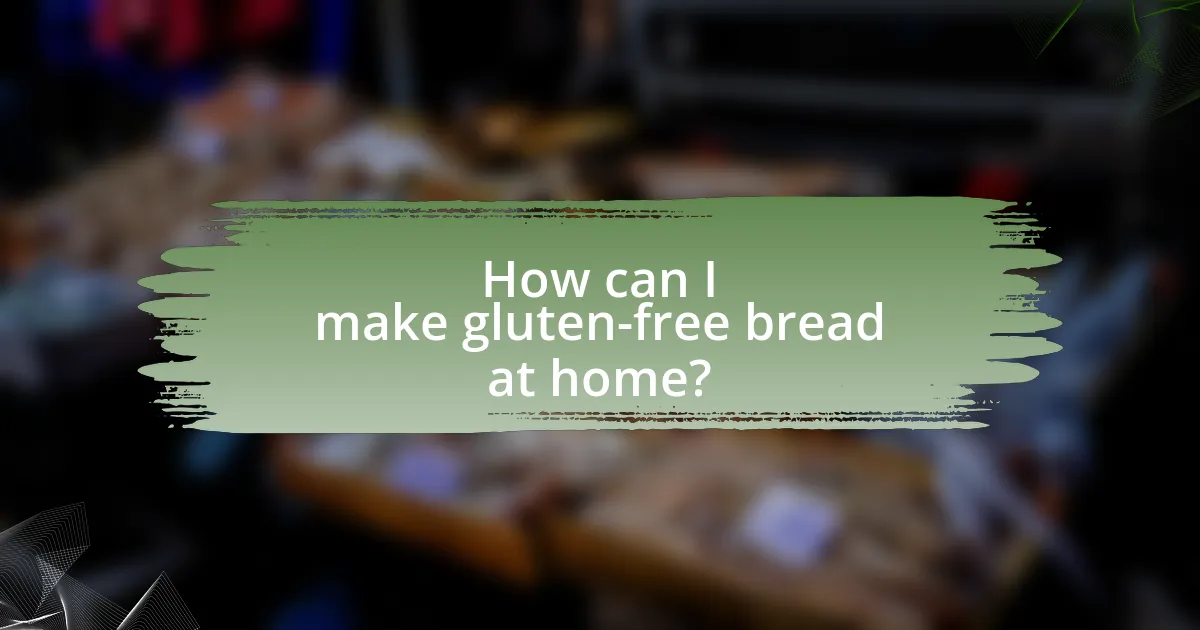
How can I make gluten-free bread at home?
To make gluten-free bread at home, combine gluten-free flour, water, yeast, salt, and a binding agent like xanthan gum or psyllium husk. Mix the dry ingredients thoroughly, then add warm water and mix until a dough forms. Allow the dough to rise in a warm place for about an hour, then shape it into a loaf and let it rise again for 30 minutes. Bake the bread in a preheated oven at 375°F (190°C) for 30-40 minutes until golden brown. Gluten-free bread typically requires different ratios and ingredients compared to traditional bread, as gluten is absent, which affects texture and rise.
What are the essential steps in making gluten-free bread?
The essential steps in making gluten-free bread include selecting gluten-free flour, mixing dry ingredients, combining wet ingredients, blending the mixtures, allowing the dough to rise, shaping the dough, and baking. First, choose a gluten-free flour blend, such as rice flour or almond flour, which provides the necessary structure. Next, mix dry ingredients like baking powder and salt in one bowl, while combining wet ingredients such as eggs and oil in another. Blend the wet and dry mixtures until smooth, then let the dough rise for a specified time to develop flavor and texture. After rising, shape the dough into a loaf and place it in a prepared pan. Finally, bake the bread in a preheated oven until it is golden brown and cooked through. These steps are crucial for achieving a successful gluten-free bread that is both tasty and has the right texture.
How do I prepare the ingredients for gluten-free bread?
To prepare the ingredients for gluten-free bread, first gather gluten-free flour, which can include a blend of rice flour, almond flour, and tapioca flour. Measure the required amounts accurately, typically around 2 to 3 cups of flour depending on the recipe. Next, add a binding agent such as xanthan gum or psyllium husk, usually about 1 teaspoon per cup of flour, to help mimic the elasticity of gluten. Then, incorporate other ingredients like salt, sugar, and yeast, ensuring they are gluten-free. Finally, mix the dry ingredients thoroughly before combining them with wet ingredients like water, eggs, or oil, which are essential for the dough’s consistency. This method ensures a well-prepared mixture suitable for gluten-free bread baking.
What baking techniques are specific to gluten-free bread?
Gluten-free bread requires specific baking techniques to achieve the desired texture and flavor. One key technique is the use of a combination of gluten-free flours, such as almond flour, coconut flour, and rice flour, to mimic the structure that gluten provides. Additionally, incorporating binders like xanthan gum or psyllium husk is essential, as they help to hold the ingredients together and improve elasticity.
Another important technique is the use of hydration; gluten-free doughs often require more liquid than traditional bread doughs to achieve the right consistency. Furthermore, allowing the dough to rest can enhance the texture, as it gives the flours time to absorb moisture fully.
Proof of these techniques’ effectiveness can be found in studies that show the importance of binders and hydration in gluten-free baking, which significantly impacts the final product’s quality and structure.
What tools and equipment do I need for gluten-free bread baking?
To bake gluten-free bread, you need specific tools and equipment including a stand mixer, mixing bowls, measuring cups and spoons, a rubber spatula, a whisk, a bread pan, parchment paper, and an oven. A stand mixer is essential for thoroughly mixing gluten-free flours, which often require more blending than traditional wheat flour. Mixing bowls allow for easy preparation of ingredients, while precise measuring cups and spoons ensure accurate ingredient ratios, crucial for gluten-free baking. A rubber spatula helps in scraping down the sides of bowls and folding ingredients, and a whisk is useful for combining dry ingredients. A bread pan is necessary for shaping the loaf, and parchment paper can prevent sticking. Finally, an oven is required for baking the bread to achieve the desired texture and flavor.
Which kitchen appliances are most helpful for gluten-free bread recipes?
The most helpful kitchen appliances for gluten-free bread recipes include a stand mixer, a food processor, and a bread machine. A stand mixer efficiently combines gluten-free flours and ingredients, ensuring a uniform dough consistency. A food processor can quickly blend dry ingredients and mix in wet components, which is particularly useful for gluten-free recipes that often require precise measurements and textures. A bread machine simplifies the baking process by automating mixing, kneading, and baking, which is beneficial for achieving the right texture in gluten-free bread. These appliances enhance the ease and success of gluten-free bread making, as they cater to the unique requirements of gluten-free ingredients.
What baking pans work best for gluten-free bread?
Metal baking pans, particularly those made of aluminum or stainless steel, work best for gluten-free bread. These materials conduct heat evenly, which is crucial for achieving the desired texture and rise in gluten-free bread, as gluten-free flours often require precise baking conditions. Additionally, using a pan with a non-stick coating can help prevent the bread from sticking, ensuring easy removal and maintaining the bread’s shape. Studies have shown that metal pans outperform glass or ceramic options in terms of heat distribution, making them the preferred choice for gluten-free baking.
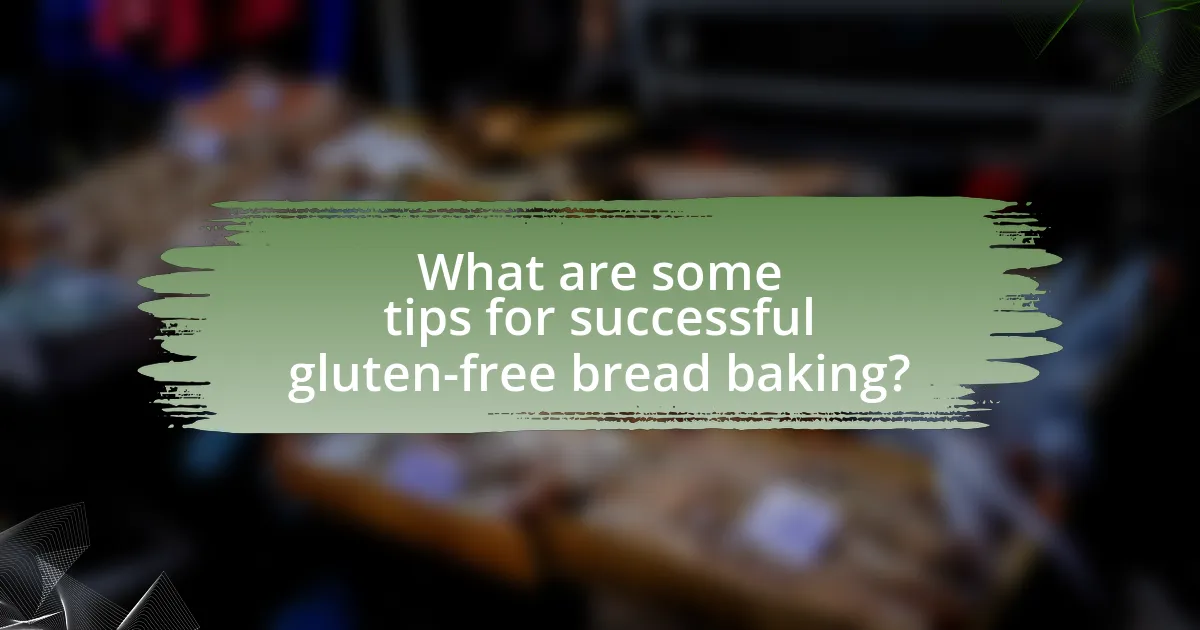
What are some tips for successful gluten-free bread baking?
Successful gluten-free bread baking requires careful ingredient selection and technique. Use a blend of gluten-free flours, such as almond, coconut, and tapioca, to achieve the right texture and flavor. Incorporating xanthan gum or psyllium husk helps mimic the elasticity of gluten, resulting in a better rise and structure. Additionally, ensure proper hydration by adding enough liquid, as gluten-free flours often absorb more moisture than wheat flour.
Proof of these methods can be found in various baking resources, which emphasize the importance of using a combination of flours and binding agents to create a desirable bread texture. For example, a study published in the Journal of Food Science highlights that gluten-free bread made with a flour blend and binding agents significantly improves the loaf’s volume and crumb structure compared to using a single flour type.
How can I troubleshoot common issues in gluten-free bread recipes?
To troubleshoot common issues in gluten-free bread recipes, first identify the specific problem, such as texture, rising, or flavor. For instance, if the bread is dense, consider increasing the amount of liquid or adding a leavening agent like baking soda or vinegar, as gluten-free flours often require more moisture. If the bread does not rise, ensure that the yeast is fresh and active, as gluten-free doughs rely heavily on proper fermentation for volume. Additionally, using a blend of gluten-free flours, such as almond, rice, and tapioca, can improve texture and flavor. These adjustments are supported by the fact that gluten-free baking often requires different ratios and ingredients compared to traditional bread-making, as outlined in resources like “Gluten-Free Artisan Bread in Five Minutes a Day” by Jeff Hertzberg and Zoë François.
What should I do if my gluten-free bread is too dense?
To lighten dense gluten-free bread, incorporate additional leavening agents such as baking powder or baking soda. These agents help create air pockets, improving the bread’s texture. Additionally, ensure that you are using the right flour blend; a combination of gluten-free flours, such as almond flour and tapioca flour, can enhance lightness. Furthermore, consider increasing the hydration level by adding more liquid or using ingredients like yogurt or applesauce, which can contribute moisture and improve the crumb structure.
How can I improve the texture of my gluten-free bread?
To improve the texture of gluten-free bread, incorporate a combination of gluten-free flours, such as almond flour and tapioca flour, which provide better structure and moisture. Using xanthan gum or psyllium husk can also enhance elasticity and mimic the texture of gluten. Research indicates that the right blend of flours and binding agents significantly affects the final product’s texture, leading to a more desirable crumb and chewiness.
What are some best practices for storing gluten-free bread?
To store gluten-free bread effectively, keep it in an airtight container or resealable plastic bag to maintain moisture and prevent staleness. Gluten-free bread tends to dry out faster than regular bread due to the absence of gluten, which provides structure and moisture retention. For longer storage, freezing gluten-free bread is recommended; wrap it tightly in plastic wrap and then place it in a freezer bag to prevent freezer burn. Research indicates that gluten-free bread can maintain quality for up to three months in the freezer. When ready to use, thaw the bread at room temperature or toast it directly from the freezer for optimal texture.
How can I keep gluten-free bread fresh for longer?
To keep gluten-free bread fresh for longer, store it in an airtight container or resealable plastic bag at room temperature. This method minimizes exposure to air, which can cause the bread to dry out or become stale. Additionally, for extended freshness, consider freezing gluten-free bread; it can last up to three months in the freezer without significant loss of quality. When ready to use, thaw it at room temperature or toast it directly from the freezer. These storage techniques are effective because they limit moisture loss and prevent mold growth, ensuring the bread remains palatable for a longer period.
What are the best methods for freezing gluten-free bread?
The best methods for freezing gluten-free bread include wrapping it tightly in plastic wrap, placing it in a resealable freezer bag, and using airtight containers. Wrapping the bread prevents freezer burn and moisture loss, which is crucial for maintaining texture and flavor. Research indicates that gluten-free bread can lose quality quickly if not stored properly; thus, using these methods can extend its shelf life for up to three months without significant degradation in quality.
What are some creative ways to use gluten-free bread?
Gluten-free bread can be creatively used in various ways, such as making gluten-free croutons, which can enhance salads and soups. To prepare croutons, cut the bread into cubes, toss them with olive oil and seasonings, and bake until crispy. Another innovative use is transforming gluten-free bread into a base for mini pizzas; simply top slices with sauce, cheese, and toppings, then bake until the cheese melts. Additionally, gluten-free bread can be used to create French toast by soaking slices in a mixture of eggs and milk, then frying them until golden brown. These methods not only utilize gluten-free bread effectively but also cater to diverse culinary preferences.
How can gluten-free bread be incorporated into meals and snacks?
Gluten-free bread can be incorporated into meals and snacks by using it as a base for sandwiches, toast, or as a side with soups and salads. For example, gluten-free bread can serve as a substitute for traditional bread in a turkey sandwich, providing a similar texture and flavor while accommodating dietary restrictions. Additionally, it can be toasted and topped with avocado or nut butter for a nutritious snack. Studies show that gluten-free diets can be beneficial for individuals with celiac disease or gluten sensitivity, making gluten-free bread a practical choice for those individuals.
What are some unique recipes that feature gluten-free bread?
Unique recipes that feature gluten-free bread include gluten-free bread pudding, where gluten-free bread is combined with eggs, milk, and spices, then baked until set, creating a comforting dessert. Another option is gluten-free bruschetta, which involves toasting slices of gluten-free bread and topping them with a mixture of diced tomatoes, basil, garlic, and olive oil for a fresh appetizer. Additionally, gluten-free French toast can be made by soaking gluten-free bread in a mixture of eggs, milk, and cinnamon before frying it, resulting in a delicious breakfast dish. These recipes highlight the versatility of gluten-free bread in various culinary applications.



